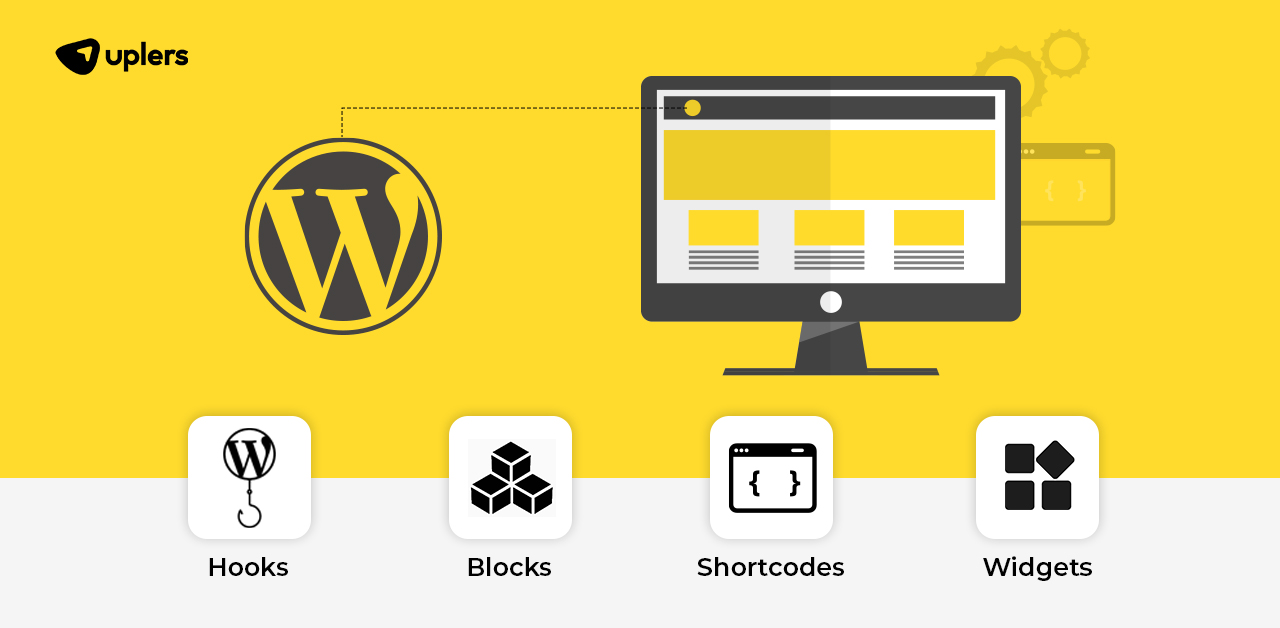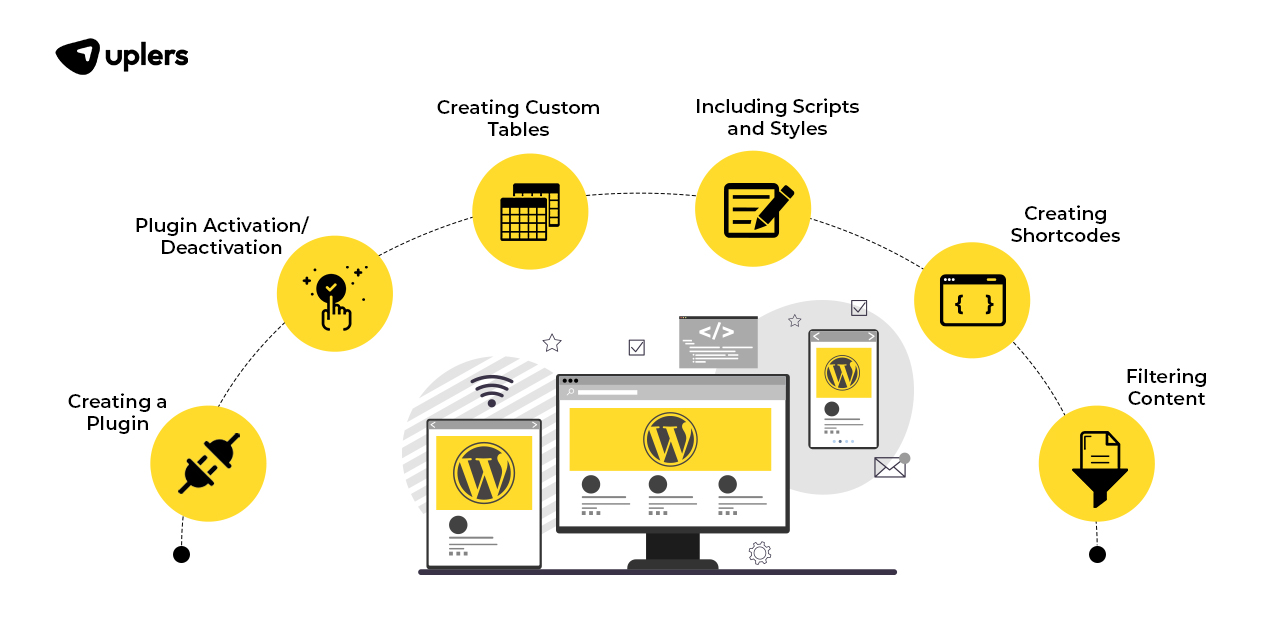WordPress Plugin Development : Create WordPress Plugins from Scratch
- Siften Halwai
- October 19, 2022
- 12 Minute Read

WordPress plugins allow businesses and brands to incorporate custom features into their WordPress site. As a result, WordPress Plugin Development grants you a WordPress website that is truly as unique as you. You have to decide while developing WordPress plugins, which one to be used between WordPress.com VS WordPress.org. Currently, there are more than 60,000 WP plugins available, which offer you immense flexibility to pick and choose what works best for you.
Plus, if you do not find what you need, you can always make your own WordPress plugin, given the platform’s open-source nature! Even though WordPress plugin development sounds super technical, you can make WordPress plugins with just basic knowledge of PHP coding, PHP file, and the right set of tools and platforms dedicated to the task. In other words, all you need is a little skill and some guidance to develop the best WordPress plugins.
So, are you curious about WordPress Plugin Development but don’t know where to start? Well, you have come to the right place. Here is a detailed guide on how to create a WordPress plugin from scratch!
What is WordPress Custom Plugin?
Before we get into the depths of how to build a plugin for a WordPress site, let us first talk about WordPress plugins. More specifically, about WordPress custom plugins.
WordPress plugins are essentially packages of code that add to the feature or functionality of your website. These functions and features are independent of your WordPress site theme and persist even when you modify the website to some degree. In this way, you can be among the top WordPress Plugin Developer.
Different WordPress plugins serve different purposes. For instance, WordPress allows you to create a plugin and WordPress plugin directory to add social media share buttons to your website that can make your personal blogs more shareable. Similarly, you can use plugins in your business website to accept customer lead information through forms.
Creating a custom WordPress plugins grant modularity to every WordPress platform as you can expand on a basic website and personalize it however you please. The key takeaway is that these plugins are specific to your requirements rather than a generalized offering. As such, the possibilities for customizing a branded website using WordPress custom plugins are virtually endless.
What is WordPress Plugin Development?
Now that you have a fair idea of WordPress plugins, let’s move on to WordPress Plugin Development.
As the name indicates, WordPress Plugin Development is the process of creating plugins for your WordPress website. It can be carried out by anyone – businesses, individuals, freelancers, outsourced agencies, you name it. Depending on the actors and stakeholders involved, the process of creating a plugin on WordPress may vary. To find a WordPress experts, it is always a safer move for any business to understand the WordPress Plugin Development process.
However, it typically involves taking stock of your requirements, arranging them in order of priority, and creating WordPress plugin with a database. Of course, this is a simplified overview of WordPress Plugin Development but stick around as we will get into the step-by-step details of how to develop WordPress plugins in the subsequent sections.
Why Should Businesses Develop WordPress Plugins?
So, we have gone over the basics of WordPress custom plugins and WordPress Plugin Development, which brings us to the next question – why bother in the first place?
As we have already said, there is no shortage of options in the WordPress plugin repository, given the platform’s open-source nature. Then why should businesses create custom plugins in WordPress?
Here are a few pointers that may shed some light:
Allows to Create Custom Plugin
WordPress plugin development allows businesses and brands to create bespoke plugins that are unique to their WordPress site. As a result, they will help your website stand out from the rest.
Enables to Add Features
By adding to the feature set or functionality of your WordPress website, plugins can play a pivotal role in addressing specific problems affecting your website or the business as a whole.
Independent WordPress Theme
The features and functionalities added to WordPress through plugins are independent of the WordPress theme Developer. As such, even if you were to switch themes, it will not affect the performance of your website.
Easy to Upgrade
It is easier to integrate, test, and upgrade custom plugins as your developers would know all the ins and outs of the plugin. At the same time, these plugins would deliver higher performance for your WordPress website as they were built for it.
A Competitive Defender
The WordPress custom plugins that you develop need not be shared with the WordPress plugin repository. So, if the plugin is acting as a competitive differentiator, it will remain so under your exclusive ownership.
Enjoy Public Support
If you were to create plugins for WordPress and put them in the public domain, your creation will enjoy immense support from the WordPress development community and their contributions can further improve and refine it.
Security
While the WordPress plugin repository contains a rich set of plugins, they are still susceptible to security threats when compared to plugins created in-house. Plus, in WordPress custom plugins also enjoy active support and maintenance.
One of the greatest reasons in favor of creating a plugin in WordPress is that it is highly accessible to all. As stated, WordPress Plugin Development can be carried out by anyone who has the means and motive. Even if you do not hire a dedicated WordPress development team, you can always outsource WordPress Plugin Development or engage talent in the short term to create plugins in WP.
Prerequisites to Create WordPress Plugin: How Plugins Work

Before you create WordPress Plugins, you also need to understand how they work. Rather than giving a breakdown of the WordPress step-by-step plugin functioning, let’s focus on the four core WordPress elements that come into play. If you want to create a WordPress plugin you must know these prerequisites.
Hooks
Hooks are WordPress features that allow developers to manipulate a process without impacting the WordPress core files. They achieve such a level of isolation by attaching code snippets or functions through hooks to the WordPress core at various points. Hooks are contextual and can be classified into Action hooks and Filter hooks.
Actions
Action hooks correspond to a process in WordPress. Some common processes include creating, reading, or saving a post in WordPress. However, you can also customize the action and action code. Action hooks are called with the function add-action().
Filters
Filter hooks are used to modify a process or the data generated by functions. They help manipulate existing data without altering the source. These hooks are called using the apply-filters() function, which requires the name of the filter and the value it will filter.
Blocks
Since the release of the block editor (“Gutenberg“) in WordPress 5.0, blocks have been an important part of how WordPress plugins work.
Depending on the functionality of your plugin, you may want to consider using blocks to enable users to interact with it, such as inserting plugin content or even creating content using your plugin.
To use blocks in your plugin, you’ll need a solid understanding of JavaScript, Node.js, React, and Redux, which has turned off some developers because WordPress plugin development used to be much more PHP-focused.
Shortcodes
Shortcodes are a portmanteau of shortcuts and code. They are used to insert dynamic HTML elements into a post or a page. They are typically defined using square bracket tags and each shortcode performs a specific dynamic function at the client end.
Widgets
Widgets offer developers another medium to display the plugin content at the front end. The WP widget class in PHP can be used to extend the widget creation for a plugin as well.
How to Make a WordPress Plugin: A Step-by-Step Guide to WordPress Plugin Development
Now that we have covered all the basics of WordPress plugin development, it is safe enough to kickstart this guide on how to create a WordPress plugin. Here is a detailed 8-step guide to developing WordPress plugins. So, you’ll be going to learn how to make simple plugins in WordPress step by step.
Step 1: Conduct Research and Plan Plugin Development in WordPress
As of date, there are 60,261 free plugins available in the WordPress plugin repository. In other words, you have 60,261 options. As such, the first step of how to build a WordPress plugin involves building a case to justify such a decision.
Note down your requirements and start exploring the WordPress plugin repository. Start by looking at the active number of installations to see if there is a market for such a plugin. The gaps, if any, would be evident at first glance.
Even if you do find solutions that meet your baseline expectations, probe them further to identify their shortcomings. Have these plugins not been updated in some time? Are they compatible with the latest versions of WordPress? Rather than create new plugins in WordPress, adopt such plugins and upgrade them if you don’t wish to start from scratch. Alternatively, you can develop complementary solutions to such WordPress plugins.
Step 2: Settle on a Staging Environment (and Set it Up)
Next on how to make a simple plugin in WordPress: a step-by-step guide, you have to set up a testing environment. A staging environment ensures that you can build a WordPress plugin without breaking a live website. It does so by creating a clone of your website, with restricted access so that you can build functionalities or experiment with features without affecting your live website. Once you are satisfied with the outcome, you can easily push/pull these changes.
There are three primary ways in which you can set up a WordPress staging website. These are:
- Create a staging website using your web host
- Install a plugin to create a WordPress staging site
- Build a manual WordPress staging site
You can also use WordPress development tools and third-party platforms to test sites locally. The choice depends purely on your comfort, preferences, and capabilities.

Step 3: Create a WordPress Plugin Folder and File
After you have set up the staging environment, now is when you can get down and dirty with Plugin Development in WordPress.
After you have set up the staging environment, now is when you can get down and dirty with Plugin Development in WordPress.
Start by choosing an official name for your plugin. You want something that would be unique but also self-explanatory about what your plugin does. The name that you choose at this stage should also reflect in the plugin folder and the PHP files, so choose wisely!
Once the name is out of the way, you can get on the WordPress testing environment to create a plugin folder and main plugin file. Navigate to the wp-content/plugins folder of WordPress and create a new folder for your plugin folder. Use the name that you have given the plugin and replace the spaces with hyphens. For example, if you are looking to create a WordPress Plugin with the name “Site Duplicator,” the folder name would be “site-duplicator.”
Now that the plugin folder is ready, you need to create a PHP file inside. Depending on the complexity of the WordPress plugin development, you may require a single file or multiple files. Either way, follow the same naming convention as your plugin and folder name. To illustrate with the above example, your file name would be “site-duplicator.php.”
Step 4: Define the WordPress Create Plugin File Header
After you develop the WordPress Plugins file, it is time to add the main plugin file header. In simplest terms, it is a PHP block comment that acts as the metadata for the WP create plugin.
Here’s what it will contain:
/**
* Plugin Name: Your Plugin Name
* Plugin URI: http://your-site.com
* Description: Insert a brief description of what your plugin does here.
* Version: 1.0.0
* Author: Your Name
* Author URI: http://your-site.com
* License: GPL2
*/
Needless to say, you will have to tweak this code snippet with the details of the WordPress plugin development project. You can also add additional details about the plugin, such as the author, license, etc. Also, if the WordPress plugin directory contains multiple PHP files, note that the plugin file header only needs to be added to one of them.
Save these changes, and the main plugin file will now be visible on your WordPress website under the Plugins tab.
Step 5: Add Code to WordPress Plugin Development
At this stage of Plugin Development in WordPress, you have built a basic framework for the plugin. However, your plugin does not serve any function yet. As such, you need to learn how to code a WordPress plugin.
Remember the elements of WordPress plugin development that we discussed in the previous section? Here is where you will see them in action. The action hooks will allow the plugins to add or modify WordPress functionality, and the filters will modify the functionality of actions – and so on. There are several ways in which you can program your WordPress plugin. However, we recommend starting off with familiarizing yourself with the WordPress Developer’s Plugin Handbook and using it as your guide. Once your concepts are clear, you can have fun designing the plugin code and experimenting with it.
Step 6: Configure, Test, and Backup the WordPress Plugin
Creating a WordPress plugin is just half the battle won. The other half relates to configuring, testing, and securing the custom WordPress plugin before it is ready for release! While most developers leave this facet of WordPress plugin development for the last, we highly recommend testing and backing up data at different milestones of the development cycle.
Such an approach prevents the avalanching of errors that can otherwise have a catastrophic effect on your WordPress plugin. Once you have successfully managed to create the WordPress plugin and are happy with how it works, you should schedule another round of testing, primarily from a security and integration angle.
WP-CLI is the command-line interface for WordPress and can be an instrumental tool for updating, configuring, testing, and integrating your WordPress plugin – even across websites!
Step7: Publish and Distributed the WordPress Plugin
Once you have successfully created the WordPress Plugin and tested its functionality and performance, you need to move to how to add a WordPress plugin to your website.
Here’s a quick look at how to add a new plugin to WordPress:
- The WordPress plugin file would be available as a .zip file on your local drive.
- One your WordPress dashboard, navigate to Plugins > Add New > Upload Plugin > Choose File.
- Then search for the .zip file and upload it to your WordPress website. WordPress will unpack and install the plugin to your site.
After the WordPress plugin is added to your directory, click on the Activate link on the Plugins screen. Just like that, your WordPress plugin will be live!
While the typical custom WordPress plugin development cycle stops here, you may create WordPress Plugin for distribution purposes. In such cases, you can publish your WordPress plugin directly to the WP plugin directory or share the plugin file on your WordPress site. Also, always test your plugin before activating the plugin.
Best Practices for Developing WordPress Plugins
Congrats on learning how to create WP content plugins for a website on WordPress. However, there is a vast amount of difference between how to make a plugin and how to create your plugin using the best practices. If you are still confused, it would be suggested to find a WordPress Designer first and then move forward.
Here’s
Here are some best practices for custom WordPress plugin development:
- Follow the WordPress Codex diligently, as it is the gold standard for language-specific coding on WordPress. It will also standardize the process while working as a team.
- Develop and test your WP plugin and WP plugin directory in a staging environment so that you will not be breaking a live website with faulty code.
- Follow a logical folder structure. Create subfolders for every functionality and split the code based on the programming language to make it more manageable.
- Adopt a consistent naming convention. Use standardized prefixes for files, folders, and elements to identify and prevent them from clashing with WordPress core elements.
- Label every function with comments so that the code is easier to debug.
- Maintain solid documentation, especially when you are working on complex plugins or WordPress plugin development that involves multiple players.
- Use version control software to track any changes made to the code and revert to previous versions if required. It will also help in preventing clashes between updates.
- Use a debugging tool to locate, isolate, and correct bugs, which will speed up WordPress plugin development.
Skills Required to Develop a WordPress Plugin
As mentioned, WordPress plugin development requires knowledge of PHP and other PHP files. However, you will also come across excellent WordPress Developers with expertise in HTML, CSS, JavaScript, Bootstrap, and SQL, who would be more adept at overall WordPress development.
FAQs on How to Create WordPress Plugins
Here are some of the Frequently Asked Questions on WordPress Plugin Development
Q1: What does it cost to develop a WordPress plugin?
A: WordPress Plugin Development may cost anywhere between $15-$75 per hour or a lump sum of $1000-$5000, depending on your plugin complexity and timelines.
Q2: Is WordPress plugin development easy?
A: Plugin Development in WordPress is easy, thanks to its thriving community of developers. However, you would still require some coding knowledge to get it right.
Q3: How long does it take to create a plugin on WordPress?
A: The timeline to create a WordPress Plugin depends on your requirements. It can take anywhere between a day to a month (or even more), depending on the complexities.
Q4: Why hire a WordPress developer?
A: While you can make your own WordPress plugin, we would highly recommend hiring WordPress experts as such a decision will grant you higher ROI in terms of development timelines, end results, WP content plugin performance, code maintenance, support, documentation, best practices, etc.
Q5: How do I add my plugin to the WordPress directory?
A: First, ensure that your WordPress plugin development follows the highest standards of coding and code maintenance. You may also go through the guidelines and ensure that your submission adheres to them. Then, log into the WordPress plugin repository and submit your plugin. The WordPress staff will manually review it in 1-10 days, and you will hear from them regarding the outcome.
Q6: Do I need to license my WordPress plugin?
A: If you create the WordPress Plugin for personal use, it does not need to be licensed. However, if you plan on distributing the WordPress plugin, then you need to adopt the GPL license – even if you wish to distribute it for free.
Concluding Thoughts
WordPress Plugin Development requires time, skill, and patience. There are going to be moments when you will not be knocking it out of the park. However, give it time and practice, and you will gain mastery over how to create WordPress plugins. Use the above WordPress step-by-step guide on how to make a simple plugin.
That being said, if you do not have the time or resources to spare for this learning curve, it is always a smarter move to involve the professionals right from day one! If you are looking to hire WordPress plugin developers, then get in touch with us, and we will show you how it’s done!

Thank you for submitting the details!
We will keep your information safe. Feel free to contact us with any questions at hello@uplers.com
Please check your email for next steps shared by Robert.

















